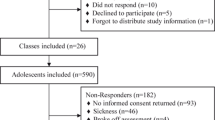Abstract
Objective
A large representative sample of early adolescents in the Netherlands was investigated to assess mental health problems in a school survey. These results were compared to results from former household surveys. In addition, several socio-demographic determinants were analysed.
Method
A random sample of schools in the Netherlands was approached for participation in the Health Behaviour in School-aged Children Survey study (response rate at school level, 60% in primary education and 45% in secondary education). Within schools, a random selection of classes from the schools participated in the study (response rate within schools >95%). We analysed the percentage of children scoring in the problem range on each of the syndromes of the Youth Self Report and compared these to the percentages found in a former population study. The impact of several socio-demographic background variables was assessed.
Results
Approximately 20% of the boys and 23% of the girls have total problem scores in the problem range. These percentages are much higher than those found in population studies in the Netherlands so far, particularly in girls. In multivariate analyses, gender, socio-economic status and family composition were found to be of influence. Migrant status does not appear to be of importance once other background variables are taken into account.
Conclusions
In school surveys on mental health problems, higher problem rates may be found than in population surveys conducted in household settings. This effect has seldom been discussed. It is suggested that this survey context has to be taken into account more explicitly when comparing results of surveys.
Similar content being viewed by others
References
Achenbach TM (1991) Integrative guide to the 1991 CBCL 4–18, YSR and TRF profiles. Department of Psychiatry, Burlington. University of Vermont, VT
Achenbach TM, Dumenci L, Rescorla LA (2003) Are American children’s problems still getting worse? A 23-year comparison. J Abnorm Child Psychol 31:1–11
Black MM, Krishnakumar A (1998) Children in low-income, urban settings. Interventions to promote mental health and well-being. Am Psychol 53:635–646
Collishaw S, Maughan B, Goodman R, Pickles A (2004) Time trends in adolescent mental health. J Child Psychol Psychiatry 45:1350–1362
Costello EJ, Angold A, Burns BJ, Erkanli A, Stangl DK, Tweed DL (1996) The Great Smoky Mountains study of youth. Functional impairment and serious emotional disturbance. Arch Gen Psychiatry 53:1137–1143
Crijnen AAM, Achenbach TM, Verhulst FC (1997) Comparisons of problems reported by parents of children in 12 cultures: total problems, externalizing and internalizing. J Am Acad Child Adolesc Psychiatry 36:1269–1277
Currie CE, Elton RA, Todd J, Platt S (1997) Indicators of socio-economic status for adolescents: the WHO Health Behaviour in School-aged Children Survey. Health Educ Res 12:385–397
Currie CW, Samdal O, Boyce W, Smith R (eds) (2002) Health behaviour in school-aged children: a World Health Organization Cross-National Study. Research protocol for the 2001/02 Survey. HBSC, Edinburgh
Ferdinand RF, Verhulst FC, Wiznitzer M (1995) Continuity and change of self-reported problem behaviors from adolescence into young adulthood. J Am Acad Child Adolesc Psychiatry 34:680–690
Hofstra MB, Van der Ende J, Verhulst FC (2002) Child and adolescent problems predict DSM-IV disorders in adulthood: a 14-year follow-up of a Dutch epidemiological sample. J Am Acad Child Adolesc Psychiatry 41:182–189
McLoyd VC (1998) Socioeconomic disadvantage and child development. Am Psychol 53:185–204
McDermott PA, Spencer MB (1997) Racial and social class prevalence of psychopathology among school-age youth in the United States. Youth Soc 28:387–414
Smit F, De Zwart W, Spruit I, Monshouwer K, Van Ameijden E (2002) Monitoring substance use in adolescents: school survey or household survey? Drugs Educ Prev Policy 9:267–274
Sourander, A, Santalahti P, Haavisto A, Piha J, Ikaheimo K, Helenius H (2004) Have there been changes in children’s psychiatric symptoms and mental health service use? A 10-year comparison from Finland. J Am Acad Child Adolesc Psychiatry 43:1134–1145
Stansfeld SA, Haines MM, Head JA, Bhui K, Viner R, Taylor SJC, Hillier S, Klineberg E, Booy R (2004) Ethnicity, social deprivation and psychological distress in adolescents. Br J Psychiatry 185:233–238
Stevens GWJM, Pels T, Bengi-Arslan L, Verhulst FC, Vollebergh WAM, Crijnen AAM (2003) Parent, teacher and self-reported problem behaviour in The Netherlands: comparing Moroccan immigrant with Dutch and with Turkish immigrant children and adolescents. Soc Psychiatry Psychiatr Epidemiol 38:576–585
Townsend P (1987) Deprivation. J Soc Policy 16:125–146
Van der Valk I, Spruijt E, De Goede M, Meeus W, Maas C (2004) Marital status, marital process, and parental resources in predicting adolescents’ emotional adjustment: a multilevel analysis. J Fam Issues 25:291–317
Verhulst FC, Van der Ende J, Koot HM (1997) Handleiding voor de youth self-report (YSR). [Manual for the Youth Self Report (YSR)]. Sophia Children’s Hospital, Rotterdam
Verhulst FC, Van der Ende J, Ferdinand RF, Kasius MC (1997) The prevalence of DSM-II-R-diagnoses in a national sample of Dutch adolescents. Arch Gen Psychiatry 54:329–336
Verhulst FC, Van der Ende J, Rietbergen A (1997) Ten-year time trends in child and adolescent psychopathology: no evidence for strong trends. Acta Psychiatr Scand 96:7–13
Verhulst FC, Achenbach TM, Van der Ende J, Erol N, Lambert MC, Leung, PWL, Silva MA, Zilber N, Zubrick SR (2003) Comparisons of problems reported by youths from seven countries. Am J Psychiatry 160:1479–1485
Wardle K, Robb K, Johnson F (2002) Assessing socio-economic status in adolescents: the validity of a home affluence scale. J Epidemiol Community Health 56:595–599
Acknowledgements
The HBSC study in the Netherlands was supported by the Dutch Ministry of Health, Welfare and Sport (VWS) and by the Stichting Jeugd Informatie Nederland (Youth information in the Netherlands, at present part of the Centre of Youth of the National Institute of Care and Wellbeing, NIZW).
Author information
Authors and Affiliations
Corresponding author
Rights and permissions
About this article
Cite this article
Vollebergh, W.A.M., van Dorsselaer, S., Monshouwer, K. et al. Mental health problems in early adolescents in the Netherlands. Soc Psychiat Epidemiol 41, 156–163 (2006). https://doi.org/10.1007/s00127-005-0979-x
Accepted:
Published:
Issue Date:
DOI: https://doi.org/10.1007/s00127-005-0979-x




